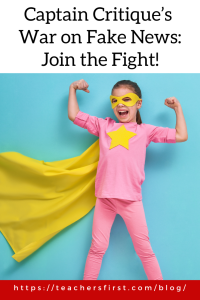Technology has transformed how information is accessed and shared, bringing opportunities and challenges to our classrooms. In this wild west of the Internet, as educators, we find ourselves in serious need of superhero skills to empower students to thrive in a dynamic and interconnected world – where misinformation lurks in the shadows, emojis function as our communication mediums and cat videos reign supreme. Fear not, fearless educators. Even if your superhero cape is in the laundry, we will equip you with tools and strategies to become a 21st-century skills superhero, Captain Critique!
As Captain Critique, picture yourself standing before your class, ready to bravely navigate the treacherous terrain of fake news and other media madness that encompasses our online world. Media Literacy has emerged as a powerful weapon to discern fact from fiction in an era where information flows freely through the Internet. Fake information and viral challenges threaten to turn our classrooms into chaos, but fear not, as media literacy emerges as the superhero sidekick we never knew we needed!
Teaching students about Media literacy requires a thoughtful approach, and fake websites provide an opportunity to engage students in critical thinking, analysis, and practical application. Let’s explore how to incorporate fake websites into a media literacy training exercise.
Define Media Literacy:
- Explain media literacy and why it is crucial in today’s digital age.
- Emphasize that media literacy involves critically evaluating and analyzing media messages, including those encountered online.
- In this post by Ruth Okoye, you will discover why media literacy is a vital skill for our students and how we need to equip them with the tools to analyze and respond to the messages they encounter.
Introduce the Concept of Fake Websites:
- Define what fake websites are and provide examples.
- The sites are designed to deceive and often present misinformation as factual.
- Stress the real-world impact fake news can have on individuals and society.
- Identify common red flags associated with fake websites, such as exaggerated headlines, spelling and grammatical errors, lack of authorship information, and unusual domain names.
- Encourage students to be skeptical and question information that triggers these red flags.
- Use the game Bad News (reviewed here) to teach students how fake news and information spreads.
Analyze Real Examples:
- Share real examples of fake websites that have circulated misinformation. Break down these examples, highlighting the tactics used to make the information appear credible. Discuss the consequences of people believing and spreading misinformation.
Develop Evaluation Criteria:
- Collaboratively create a set of criteria for evaluating the credibility of websites.
- Include factors such as authorship, publication date, references, and the site’s overall design.
- The requirements can serve as a checklist for students when assessing the reliability of online sources.
- Use the site RumorGuard (reviewed here) to teach students how to identify online misinformation based on up to five factors – source, evidence, context, reasoning, and authenticity.
The Fictional Chronicles Exercise:
- Begin with a fictional scenario where students encounter a dubious website.
- Craft a compelling narrative, complete with misleading headlines and fabricated information.
- Task students with dissecting the content, identifying red flags, and presenting their findings.
- This activity emphasizes media literacy skills but also fosters storytelling and analytical thinking.
- The Media Literacy Clearinghouse has a collection of fake websites to use with this activity.
Website Detective Challenge:
- Turn your classroom into a detective agency with a Website Detective Challenge.
- Provide students with a set of websites, including both legitimate and fake ones.
- Equip them with evaluation criteria – authorship, publication date, credibility – and encourage them to collaborate in solving the mystery of which websites are trustworthy.
- This interactive challenge sparks engagement and teamwork.
The Fake Website Gallery:
- Transform your classroom into an art gallery, showcasing a curated collection of fake websites.
- Each website in the gallery represents a unique challenge for students to unravel.
- Organize a gallery walk where students critically analyze the websites, discussing their findings and collectively building a comprehensive understanding of the tactics employed by creators of fake content.
- “Tech Out” the site, Ask a Tech Teacher, for 7 Websites to Teach Kids Fake News.
Guest Speakers and Experts:
- Invite guest speakers, such as journalists, fact-checkers, or digital literacy experts, to share their experiences dealing with fake news.
- The goal is to provide students with real-world insights and perspectives.
It’s essential to foster an open and non-judgmental environment where students feel comfortable discussing and questioning information. As Captain Critique, actively involving students in the learning process with fake websites provides practical experiences to empower students to navigate the ever-changing digital landscape with a discerning eye and responsible behavior. For more great ideas, register for our free upcoming OK2AsK virtual workshop, “Engage and Inspire with Fake Websites.” If you miss it, visit the archives to watch the recording at your convenience.
Media literacy instills in our students a sense of responsibility as digital citizens – individuals who understand the impact of their online actions. Comment below on how you integrate media literacy skills and fake websites in your classroom.


